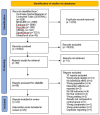What works to reduce sedentary behavior in the office, and could these intervention components transfer to the home working environment?: A rapid review and transferability appraisal
- PMID: 35966113
- PMCID: PMC9372484
- DOI: 10.3389/fspor.2022.954639
What works to reduce sedentary behavior in the office, and could these intervention components transfer to the home working environment?: A rapid review and transferability appraisal
Abstract
Background: Working patterns have changed dramatically due to COVID-19, with many workers now spending at least a portion of their working week at home. The office environment was already associated with high levels of sedentary behavior, and there is emerging evidence that working at home further elevates these levels. The aim of this rapid review (PROSPERO CRD42021278539) was to build on existing evidence to identify what works to reduce sedentary behavior in an office environment, and consider whether these could be transferable to support those working at home.
Methods: The results of a systematic search of databases CENTRAL, MEDLINE, Embase, PsycInfo, CINHAL, and SportDiscus from 10 August 2017 to 6 September 2021 were added to the references included in a 2018 Cochrane review of office based sedentary interventions. These references were screened and controlled peer-reviewed English language studies demonstrating a beneficial direction of effect for office-based interventions on sedentary behavior outcomes in healthy adults were included. For each study, two of five authors screened the title and abstract, the full-texts, undertook data extraction, and assessed risk of bias on the included studies. Informed by the Behavior Change Wheel, the most commonly used intervention functions and behavior change techniques were identified from the extracted data. Finally, a sample of common intervention strategies were evaluated by the researchers and stakeholders for potential transferability to the working at home environment.
Results: Twenty-two studies including 29 interventions showing a beneficial direction of effect on sedentary outcomes were included. The most commonly used intervention functions were training (n = 21), environmental restructuring (n = 21), education (n = 15), and enablement (n = 15). Within these the commonly used behavior change techniques were instructions on how to perform the behavior (n = 21), adding objects to the environment (n = 20), and restructuring the physical environment (n = 19). Those strategies with the most promise for transferring to the home environment included education materials, use of role models, incentives, and prompts.
Conclusions: This review has characterized interventions that show a beneficial direction of effect to reduce office sedentary behavior, and identified promising strategies to support workers in the home environment as the world adapts to a new working landscape.Systematic Review Registration: https://www.crd.york.ac.uk/prospero/display_record.php?ID=CRD42021278539, identifier CRD42021278539.
Keywords: behavior change; flexible working; home working; occupational; sitting.
Copyright © 2022 Morton, Fitzsimons, Jepson, Saunders, Sivaramakrishnan and Niven.
Conflict of interest statement
The authors declare that the research was conducted in the absence of any commercial or financial relationships that could be construed as a potential conflict of interest.
Figures
Similar articles
-
Folic acid supplementation and malaria susceptibility and severity among people taking antifolate antimalarial drugs in endemic areas.Cochrane Database Syst Rev. 2022 Feb 1;2(2022):CD014217. doi: 10.1002/14651858.CD014217. Cochrane Database Syst Rev. 2022. PMID: 36321557 Free PMC article.
-
Beyond the black stump: rapid reviews of health research issues affecting regional, rural and remote Australia.Med J Aust. 2020 Dec;213 Suppl 11:S3-S32.e1. doi: 10.5694/mja2.50881. Med J Aust. 2020. PMID: 33314144
-
Effectiveness of Mobile Health Interventions for Reducing Sitting Time in Older Adults: Systematic Review and Meta-Analysis.J Med Internet Res. 2025 May 8;27:e60889. doi: 10.2196/60889. J Med Internet Res. 2025. PMID: 40340833 Free PMC article. Review.
-
Interventions for reducing sedentary behaviour in community-dwelling older adults.Cochrane Database Syst Rev. 2021 Jun 25;6(6):CD012784. doi: 10.1002/14651858.CD012784.pub2. Cochrane Database Syst Rev. 2021. PMID: 34169503 Free PMC article.
-
Efficacy, characteristics, behavioural models and behaviour change strategies, of non-workplace interventions specifically targeting sedentary behaviour; a systematic review and meta-analysis of randomised control trials in healthy ambulatory adults.PLoS One. 2021 Sep 7;16(9):e0256828. doi: 10.1371/journal.pone.0256828. eCollection 2021. PLoS One. 2021. PMID: 34492051 Free PMC article.
Cited by
-
Understanding for whom, under which circumstances and how sedentary behaviour interventions for older adults work: a realist review.BMJ Open. 2025 Aug 10;15(8):e095775. doi: 10.1136/bmjopen-2024-095775. BMJ Open. 2025. PMID: 40784766 Free PMC article. Review.
-
Are we working (too) comfortably?: the systematic development of an intervention to support workers to move more while working at home.Int J Behav Nutr Phys Act. 2025 Jun 23;22(1):84. doi: 10.1186/s12966-025-01762-3. Int J Behav Nutr Phys Act. 2025. PMID: 40551143 Free PMC article.
-
"Are we working (too) comfortably?": a focus group study to understand sedentary behaviour when working at home and identify intervention strategies.BMC Public Health. 2024 Jun 6;24(1):1516. doi: 10.1186/s12889-024-18892-1. BMC Public Health. 2024. PMID: 38844904 Free PMC article.
-
Sedentary Behavioral Studies of Young and Middle-Aged Adults with Hypertension in the Framework of Behavioral Epidemiology: A Scoping Review.Int J Environ Res Public Health. 2022 Dec 14;19(24):16796. doi: 10.3390/ijerph192416796. Int J Environ Res Public Health. 2022. PMID: 36554675 Free PMC article.
-
A digital intervention to reduce home-office workers' sedentary behaviour: protocol for the evaluation of the Click2Move programme, a cluster randomised controlled trial.BMC Public Health. 2025 Jan 30;25(1):387. doi: 10.1186/s12889-025-21598-7. BMC Public Health. 2025. PMID: 39885479 Free PMC article.
References
-
- Bakker E. A., Hartman Y. A. W., Hopman M. T. E., Hopkins N. D., Graves L. E. F., Dunstan D. W., et al. . (2020). Validity and reliability of subjective methods to assess sedentary behaviour in adults: a systematic review and meta-analysis. Int. J. Behav. Nutr. Phys. Act. 17, 75. 10.1186/s12966-020-00972-1 - DOI - PMC - PubMed
-
- BBC News (2022). Hybrid Working Is Here to Stay, Say Managers. Available online at: https://www.bbc.co.uk/news/business-60421056 (accessed March 1, 2022).
-
- British Council for Offices (2020). Majority of Workers Plan a Return to the Office, But Home Working Here to Stay. Available online at: http://www.bco.org.uk/News/News46982.aspx2020 (accessed November 1, 2022).
Publication types
Grants and funding
LinkOut - more resources
Full Text Sources


